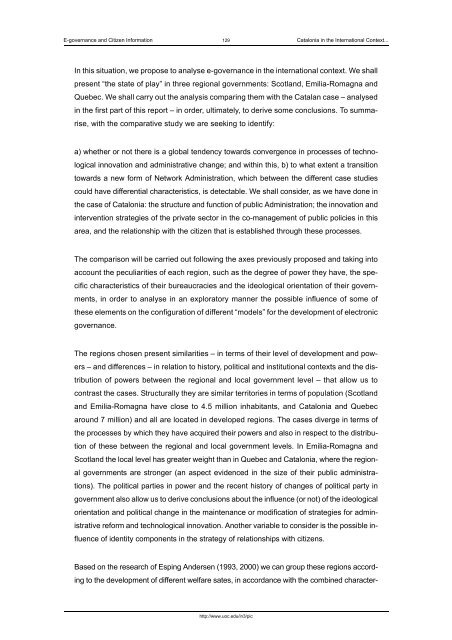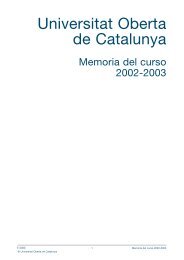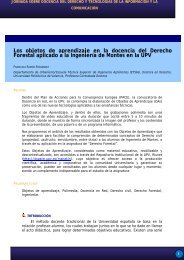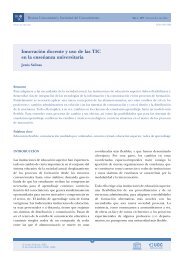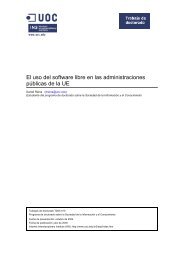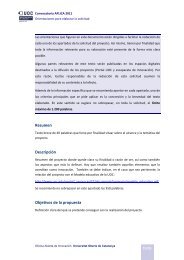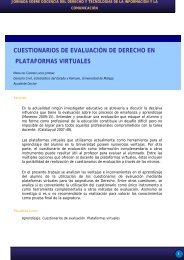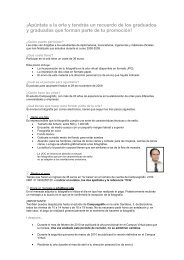e-governance and citizen information - Universitat Oberta de ...
e-governance and citizen information - Universitat Oberta de ...
e-governance and citizen information - Universitat Oberta de ...
You also want an ePaper? Increase the reach of your titles
YUMPU automatically turns print PDFs into web optimized ePapers that Google loves.
E-<strong>governance</strong> <strong>and</strong> Citizen Information 129 Catalonia in the International Context...In this situation, we propose to analyse e-<strong>governance</strong> in the international context. We shallpresent “the state of play” in three regional governments: Scotl<strong>and</strong>, Emilia-Romagna <strong>and</strong>Quebec. We shall carry out the analysis comparing them with the Catalan case – analysedin the first part of this report – in or<strong>de</strong>r, ultimately, to <strong>de</strong>rive some conclusions. To summarise,with the comparative study we are seeking to i<strong>de</strong>ntify:a) whether or not there is a global ten<strong>de</strong>ncy towards convergence in processes of technologicalinnovation <strong>and</strong> administrative change; <strong>and</strong> within this, b) to what extent a transitiontowards a new form of Network Administration, which between the different case studiescould have differential characteristics, is <strong>de</strong>tectable. We shall consi<strong>de</strong>r, as we have done inthe case of Catalonia: the structure <strong>and</strong> function of public Administration; the innovation <strong>and</strong>intervention strategies of the private sector in the co-management of public policies in thisarea, <strong>and</strong> the relationship with the <strong>citizen</strong> that is established through these processes.The comparison will be carried out following the axes previously proposed <strong>and</strong> taking intoaccount the peculiarities of each region, such as the <strong>de</strong>gree of power they have, the specificcharacteristics of their bureaucracies <strong>and</strong> the i<strong>de</strong>ological orientation of their governments,in or<strong>de</strong>r to analyse in an exploratory manner the possible influence of some ofthese elements on the configuration of different “mo<strong>de</strong>ls” for the <strong>de</strong>velopment of electronic<strong>governance</strong>.The regions chosen present similarities – in terms of their level of <strong>de</strong>velopment <strong>and</strong> powers– <strong>and</strong> differences – in relation to history, political <strong>and</strong> institutional contexts <strong>and</strong> the distributionof powers between the regional <strong>and</strong> local government level – that allow us tocontrast the cases. Structurally they are similar territories in terms of population (Scotl<strong>and</strong><strong>and</strong> Emilia-Romagna have close to 4.5 million inhabitants, <strong>and</strong> Catalonia <strong>and</strong> Quebecaround 7 million) <strong>and</strong> all are located in <strong>de</strong>veloped regions. The cases diverge in terms ofthe processes by which they have acquired their powers <strong>and</strong> also in respect to the distributionof these between the regional <strong>and</strong> local government levels. In Emilia-Romagna <strong>and</strong>Scotl<strong>and</strong> the local level has greater weight than in Quebec <strong>and</strong> Catalonia, where the regionalgovernments are stronger (an aspect evi<strong>de</strong>nced in the size of their public administrations).The political parties in power <strong>and</strong> the recent history of changes of political party ingovernment also allow us to <strong>de</strong>rive conclusions about the influence (or not) of the i<strong>de</strong>ologicalorientation <strong>and</strong> political change in the maintenance or modification of strategies for administrativereform <strong>and</strong> technological innovation. Another variable to consi<strong>de</strong>r is the possible influenceof i<strong>de</strong>ntity components in the strategy of relationships with <strong>citizen</strong>s.Based on the research of Esping An<strong>de</strong>rsen (1993, 2000) we can group these regions accordingto the <strong>de</strong>velopment of different welfare sates, in accordance with the combined character-http://www.uoc.edu/in3/pic


